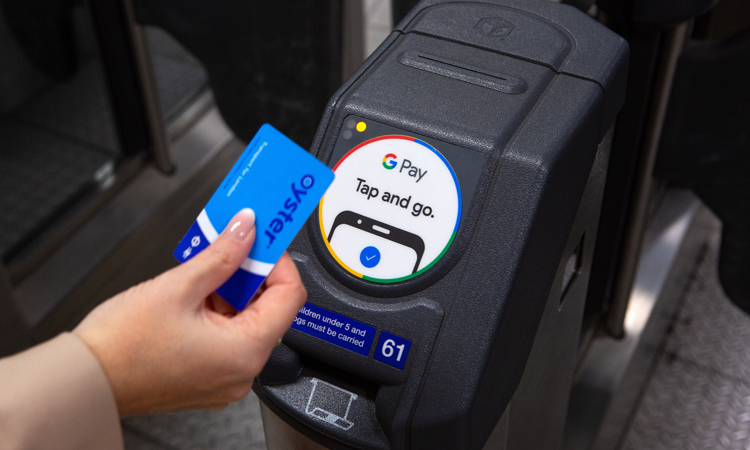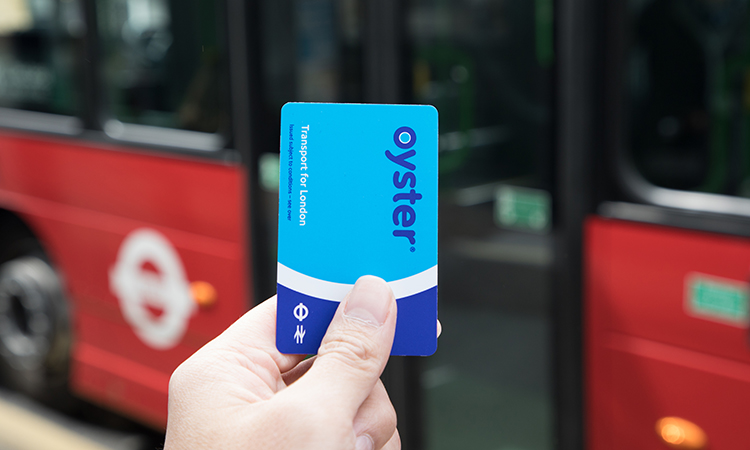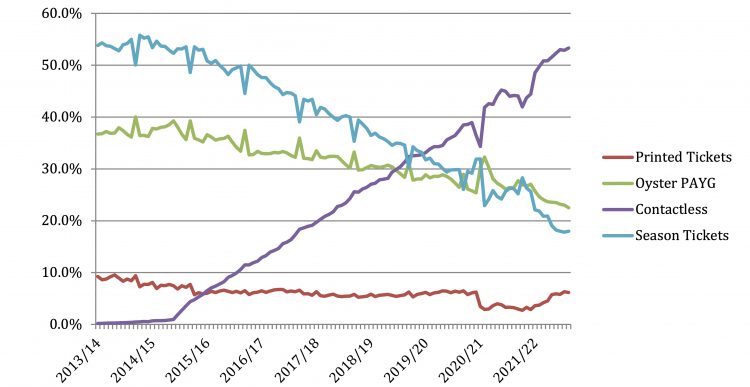Flexibility in paying for travel
- Like
- Digg
- Del
- Tumblr
- VKontakte
- Buffer
- Love This
- Odnoklassniki
- Meneame
- Blogger
- Amazon
- Yahoo Mail
- Gmail
- AOL
- Newsvine
- HackerNews
- Evernote
- MySpace
- Mail.ru
- Viadeo
- Line
- Comments
- Yummly
- SMS
- Viber
- Telegram
- Subscribe
- Skype
- Facebook Messenger
- Kakao
- LiveJournal
- Yammer
- Edgar
- Fintel
- Mix
- Instapaper
- Copy Link
Posted: 22 June 2022 | Andrew Anderson - Transport for London | No comments yet
Andrew Anderson, Transport for London’s Head of Transformation Portfolio: Payments, considers how far the Oyster card has come in its 19 years of operation and discusses why the future of flexible and convenient ticketing will be driven by contactless Pay As You Go payments.


It’s hard to conceive that the Oyster card turns 20 years old in 2023. Launched in June 2003, the blue smartcard has transformed the way that people in London travel in the subsequent decades and led the charge across the UK for smartcard technology to replace traditional paper ticketing.
At the heart of Oyster was the belief that people should have the flexibility to travel when they want to and only pay for the journeys that they make”
At the heart of Oyster was the belief that people should have the flexibility to travel when they want to and only pay for the journeys that they make. With Oyster, there was no need to queue for a ticket every time you wanted to travel and, as credit could be pre-loaded onto the card, you could also then ‘top up’ when it was convenient for you, rather than having to allow extra time to queue to buy a ticket as part of your commute or family day out.
Contactless PAYG travel
Building on this proposition, in 2014, we introduced a new revolutionary system whereby contactless payment cards could be used as an alternative to using Oyster for Pay As You Go (PAYG) travel. This brought the benefits of Pay As You Go not only to people with an Oyster card, but to anyone who had a contactless card – meaning that passengers no longer needed to get a special travel token from us to allow them to use our services. It also removed the need to pre-load credit – allowing for even more flexibility when traveling.
As part of the new proposition, the system introduced a weekly ‘cap’ for contactless users, where the amount of Pay As You Go travel charged in a fixed Monday to Sunday period would never exceed the price of the equivalent season ticket (which we call a Travelcard).
Although Pay As You Go has been a feature of the Oyster system since 2005, until this time, it largely involved switching customers from single journey or day Travelcards using old magnetic tickets. This additional benefit meant that those who previously were buying weekly Travelcards now had a flexible and convenient alternative, which gave them the best of both worlds: not paying more than the price of a weekly ticket, but not paying more than they needed to if their plans changed, by only paying for journeys as they were being made.


Following its launch in 2003, the Oyster card has transformed the way that people in London travel.
Meeting the changing needs of passengers
The introduction of Pay As You Go with contactless in 2014 meant that, in London, we saw a steady decline of season tickets as a proportion of journeys, which the COVID-19 pandemic has further accelerated. As a consequence, our existing long-term strategy, which recognises that customers are migrating away from season tickets towards the greater flexibility offered by Pay As You Go, now needs to go further to ensure that we can continue to offer the best ticketing experience for our customers.
Over the years, we have developed Pay As You Go to make it a simple, reliable product that will meet the long-term needs of our customers”
Over the years, we have developed Pay As You Go to make it a simple, reliable product that will meet the long-term needs of our customers. We have provided both daily and weekly caps to those who use Pay As You Go and, since 2015, the price of a daily cap has been 20 per cent of the price of a weekly cap, meaning that customers using Pay As You Go five days a week will not pay more than the equivalent weekly ticket price.
Responding to the impact of the pandemic
When the pandemic hit in 2020, our ridership, like all public transport authorities across the world, plummeted to levels not seen for decades, if not longer. At one point, ridership on the London Underground (Tube) was as low as five per cent of normal, pre-pandemic demand. However, once restrictions started to lift, with people making less frequent journeys or not knowing what days that they would be travelling in advance, Pay As You Go became a natural option for those who had previously used season tickets, as they could travel using just their bank card and know that they wouldn’t pay any more than the equivalent daily charge. As such, Pay As You Go helped to demonstrate to the public that a workable solution for flexible ticketing already existed in London, without the need to create a new product to cater for the part-time commuter.
Research undertaken in recent months about customers attitudes during the last two years has told us that, during the pandemic, customers have been using more varied payment methods for travel”
With season ticket numbers naturally falling and the pandemic seemingly accelerating this trend, it would be easy to think that our next step should be to quickly withdraw season tickets. However, in order to do this, we need to take our customers on the journey with us, rather than aim to force their hand. Research undertaken in recent months about customers attitudes during the last two years has told us that, during the pandemic, customers have been using more varied payment methods for travel.
The lack of certainty around travel patterns appears to have driven up Pay As You Go with contactless usage, and customers are now choosing to switch between products far more, depending on their specific needs. The research also shows that Pay As You Go is preferred for ad-hoc journeys, such as visiting family and friends or for leisure journeys, while Travelcard season tickets tend to be preferred for more regular, predictable travel around the network (e.g. commuting to work).
Therefore, we mustn’t overlook the important simplicity and loyalty towards the Travelcard. A significant number of our customers appreciate the peace of mind that paying a fixed price for unlimited travel in a defined area and time gives them. The ability to easily comprehend the concept of the Travelcard, therefore, creates its own loyalty, and purchases become an ingrained habit compared to switching to a potentially more beneficial option.


Credit: Transport for London – Graph displaying the payment methods chosen by passengers when travelling on Transport for London services between 2013/14 and 2021/22.
Taking customers on the flexible ticketing journey
To take customers on the journey to a more flexible ticketing future, customers ultimately need the following things:
- Reassurance that other people are already taking similar steps to swap season tickets for Pay As You Go
- Confidence that weekly capping means that you never pay more than your weekly ticket and that you may get better value by only paying for the journeys that you make
- Knowledge that customers can track their daily spend via the TfL app and website to help them to budget their travel and to check what they have been charged
- Knowledge that customers can easily correct incomplete journeys when they are made by mistake to save paying maximum fares
- Evidence that others have already found that they don’t use their Travelcards as much as they thought they would and have, therefore, moved to Pay As You Go.
By knowing the key concerns and requirements which will influence our customers, behind the scenes, we have already begun putting measures in place to move our messaging and systems towards addressing these. We have already made it easy for customers to access their journey history – whether at station ticket machines for Oyster, or online or via an app for both Oyster and contactless – so that they can easily check that their journeys are being accurately recorded and, therefore, instil confidence that we will always charge customers correctly for the travel that they have undertaken.
We have also implemented a number of rules to the system which will look to automatically apply refunds to customers, where it is clear that customers have forgotten to touch in or out at a station. As well as ensuring that customers pay the correct fare, this measure also further demonstrates that we are looking out for customers and are not out to overcharge them – which can provide further reassurance for those who are unsure whether to change.
Outside factors encouraging contactless ticketing adoption
There are also external forces which will help to further transition customers from traditional Travelcards to Pay As You Go. Contactless has increasingly become an integral way of paying and is now the default way for many people to pay for goods, particularly since the contactless payment limit has risen to £100. Additionally, the recent change in working patterns means that the benefit of the season ticket has been eroded for many commuters, given the adoption of more flexible working.
The final external force which will influence take up is the area which is served by Pay As You Go. While Pay As You Go is heavily used by those within London, those who commute into London from outside of the capital will be more inclined to purchase Travelcards, as their starting station will be outside the Pay As You Go area. If they use Pay As You Go, they would still have to purchase a separate ticket to travel into London, and a Travelcard ensures that there is one large upfront payment and, therefore, no need to queue at ticket machines every morning.
Since the introduction of Pay As You Go with contactless in 2014, the Pay As You Go area has expanded, as has work with Train Operating Companies (TOCs) to expand the system beyond the edges of the existing London zonal fares system, such as to Dartford, Swanley and Gatwick Airport. To further aid the system’s expansion, in April 2020, we introduced a new fares logic which allowed Pay As You Go on contactless to extend beyond the traditional London boundaries for the first time. This meant that we were now able to deliver extensions of Pay As You Go on contactless to key commuter towns around London, such as Reading, Luton Airport Parkway and Welwyn Garden City.
Due to technical constraints, these new extensions could only be made with contactless rather than the Oyster system. Being nearly 20 years old, the Oyster system was designed specifically for London’s concentric fare zones and, therefore, is incompatible with the differing pricing structures which exist on the rail corridors into London. As the contactless system is more modern and back-office based, it was designed to cater not only for more complex fare structures, but also the ability to be extended to new routes as future opportunities arise.
The future of flexible Pay As You Go ticketing
The development of Pay As You Go – first through Oyster 20 years ago and now with contactless – and the customer-focused system improvements that we have subsequently made has transformed travel across London. With the pandemic requiring businesses of all kinds to be more flexible, and customer trends and travel patterns changing, the adoption of Pay As You Go as the primary method for paying for travel gives customers the flexibility and confidence to travel when they want. In the late 1970s, a UK-based credit card coined the phrase “your flexible friend” to market its product – 50 years on, Pay As You Go ticketing can be just that.


Related topics
COVID-19, Passenger Experience, Public Transport, Ticketing & Payments
Issue
Issue 1 2022
Related modes
Tube, Underground
Related cities
London
Related countries
United Kingdom
Related organisations
Transport for London (TfL)
Related people
Andrew Anderson







